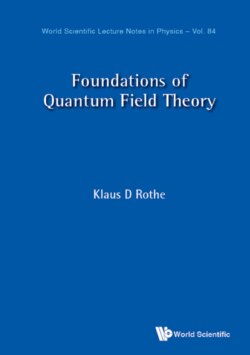Читать книгу Foundations of Quantum Field Theory - Klaus D Rothe - Страница 21
На сайте Литреса книга снята с продажи.
Probability interpretation
ОглавлениеIn order for the wave function to have the interpretation of a probability amplitude, it should have at least the following properties:
(i) Its normalization with respect to some suitable integration measure should be independent of time, as well as of the choice of inertial frame.
(ii) The associated probability density should be positive semi-definite.
The second condition is satisfied by defining the probability density by
Furthermore, adopting the following definition for the scalar product
and making use of the equation of motion (3.1), one finds that the normalization of the wave function is preserved in time:
The probability of finding a particle anywhere in space should, however, also be independent of the choice of inertial frame. Since the wave function ϕ(, t) transforms like a scalar (see Eq. (3.3)) this is not the case due to the Lorentz non-invariance of the measure d3r.
For the case of a free particle this defect is easily repaired by adopting a new definition for the scalar product:
Indeed, making use of the Fourier decomposition (3.4) for a free particle wave function, one computes
Because of the invariance property (2.43) of the integration measure, and the scalar property (3.5) of the Fourier amplitude, we conclude that the normalization of the wave function is a Lorentz invariant with respect to the scalar product (3.6). In fact, one easily shows that it has all the properties expected from a scalar product:
and
for solutions of the equation of motion. The scalar product (ϕ, ϕ)t is also time-independent, as one easily checks using the equation of motion (3.2):
for ∂V → ∞ and ϕ → 0 at infinity. In fact, the probability density satisfies a continuity equation analogous to that in non-relativistic Quantum Mechanics:
where
We may in fact collect and j(, t) into a 4-vector as follows:
where . Indeed, under a Lorentz transformation we have (compare with (2.5))
Although we have succeeded in satisfying the requirement (i), this is not the case as far as requirement (ii) is concerned. As a simple example shows, the probability density is not a positive semi-definite quantity. To see this, consider the superposition of two plane waves for two free particles of mass m:
with k · x = kμxμ, etc.
Let c and d be real. One then has
Now, for every 4-vector (k − q)μ there exists a vector xμ such that (k − q) · x = 0. For this vector
We may then rewrite the above expression as
The matrix appearing here is hermitian, and may thus be diagonalized, its eigenvalues being
Hence, though the total probability is positive, the density in space-time is not. Since λ− < 0, there always exist coefficients such that , which proves our claim.
